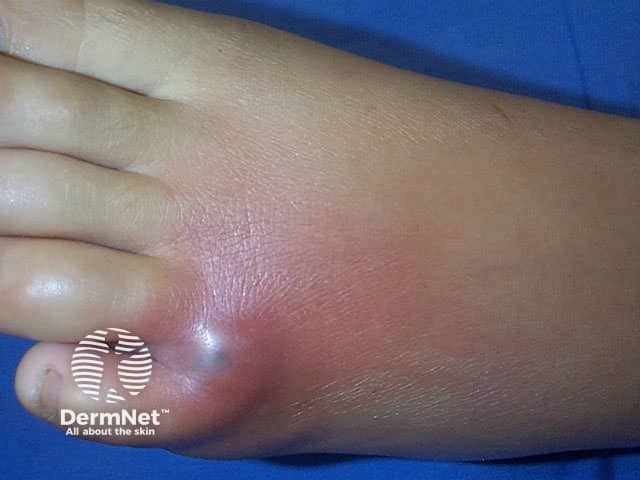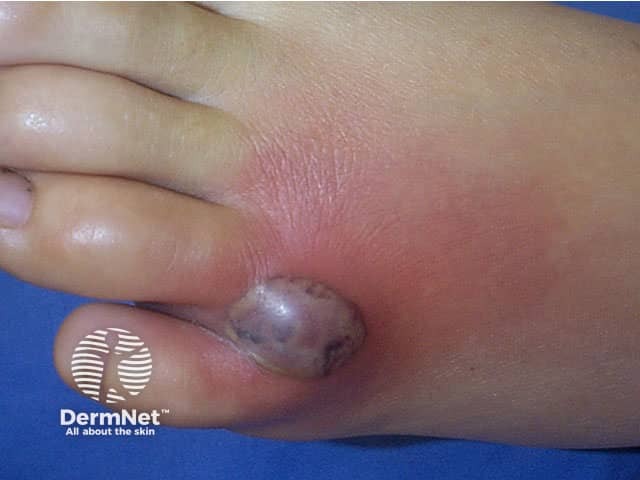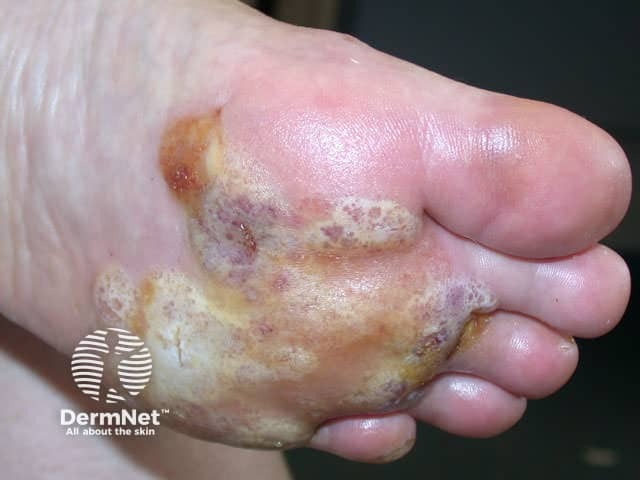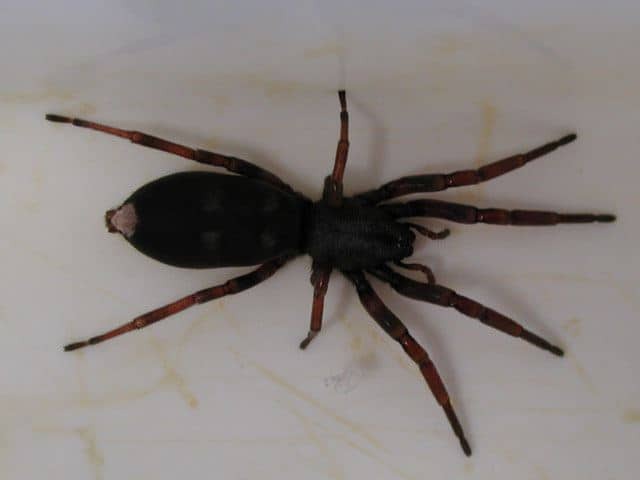Main menu
Common skin conditions

NEWS
Join DermNet PRO
Read more
Quick links
Created 2008.
The order Arachnida includes spiders, ticks, mites and scorpions. Like insects, they are arthropods, which are invertebrates with chitinous exoskeletons, bilateral symmetry, true segmentation and jointed true appendages. Arachnids are characterised by adults without wings or antennae, four pairs of legs and two body segments. They act as parasites by living on the skin (scabies mites) or transiently feeding through the skin (lice). Irritant and allergic reactions occur in the human host. Ticks and mites may transmit other contagious diseases.
Few spiders are dangerous to humans. The majority of medically important spider bites can be attributed to widow spiders (Latrodectus spp.) and recluse spiders (Loxosceles spp.).
Latrodectus bites are painful and may rapidly result in local erythema, sweating and piloerection at the wound site. Black widow venom causes depletion of acetylcholine at motor nerve endings and release of catecholamines at adrenergic nerve endings. The result is agonising abdominal pain and muscle spasm, headache, paresthesias, nausea, vomiting, hypertenion and paralysis. Luckily death is uncommon. Treatment is with intravenous calcium gluconate, analgesics and antivenin.
In New Zealand, the rare katipo (Latrodectus katipo) and Australian red-back (Latrodectus hasselti) may be responsible; antivenin is available.
Necrotising spider bites may arise painlessly but later result in painful erythematous plaques and vesiculation. Tissue necrosis and mild systemic toxicity arises 3 or 4 days later. The wound forms an eschar between the 5th and 7th day. As the bite is often unnoticed, the causative spider is rarely collected.
Histology is characterised by neutrophilic perivasculitis, haemorrhage and oedema. Older lesions have epidermal necrosis, ulceration, arterial wall necrosis and a prominent eosinophlic infiltrate.
Day 1 Day 2 Day 3 Another case 



White tailed spiders (Lampona cylindrata) may be responsible for this presentation in New Zealand. They live in dark corners in houses and sheds and do not make webs. They may be disturbed when putting on gumboots or gardening clothes. Symptomatic management is indicated; the necrotic tissue may need to be debrided.
White tail spider 
Mites have a distinct gnathosoma (mouthparts) and no division between abdomen and cephalothorax. Demodex folliculorum resides in the hair follicles of the nose and cheeks. They have not been proven to cause disease but have been implicated in rosacea and a sandpaper-like facial rash, pityriasis folliculorum.
Food, grain and harvest mites may crawl onto exposed skin of food-handlers and irritate the skin resulting in tiny red bumps and blisters (hypersensitivity dermatitis). Skin scrapings may reveal the mites, which do not feed on blood.
Mites that infest birds, mice/rats or other animals may rarely affect exposed areas of handlers. Occasionally there is systemic toxicity with fever, gastrointestinal symptoms and malaise. Lesions may be erythematous macules or papulovesicles. Harvest mites or chiggers are the larval form of Trombiculidae mites. Infestation presents in endemic areas during the autumn with intensely pruritic 2mm papules on the ankles, legs or belt line; the initial bite is painless and the chiggers drop off after feeding lymph and dissolved tissue. Chiggers may transmit scrub typhus.
Cheyletiella mites cause asymptomatic scaling on dogs, cats and rabbits and do not burrow. Their owners may have an itchy eruption on contact sites; in severe cases blisters may appear. Tthe mite does not burrow in human skin and scrapings are negative. The pets should be treated with insecticides by the veterinarian.
Dog, pig and horse scabies mites are burrowing mites and cause itch in infested animals. However they do not burrow in human skin so only affect contact areas such as trunk and arms. Refer to section on human scabies.
Ticks are very important vectors of systemic disease and ingest blood from diverse vertebrate hosts. The ticks wait on tall grass or bracken during spring and summer. They are attaracted to the host by sweat, white colour and body heat. They look for a protected site to feed such as a skinfold, engorge themselves with blood and drop off a day or so later. The bites are not painful. They may induce foreign body and hypersensitivity reactions, usually a red papule at the bite site. The lesion may persist for months forming a granuloma. The most effective tick repellents are permethrin applied to clothing and DEET on exposed skin surfaces.

Ticks are responsible for the spread of many contagious diseases, including:
Scorpions have a bulbous sac and pointed stinger at the end of the tail-like abdomens, and strong claws to grasp their prey. They are not present in New Zealand; pseudoscorpions can be confused but don't have a stinging tail. Scorpion stings produce an immediate pain followed by spreading numbness due to neurotoxins. Some species in arid areas of the USA and North Africa result in generalised neurotoxicity and death. Specific antivenin is available.
What is the evidence that white tail spiders cause, or do not cause, necrotic arachnidism?
Information for patients
See the DermNet bookstore